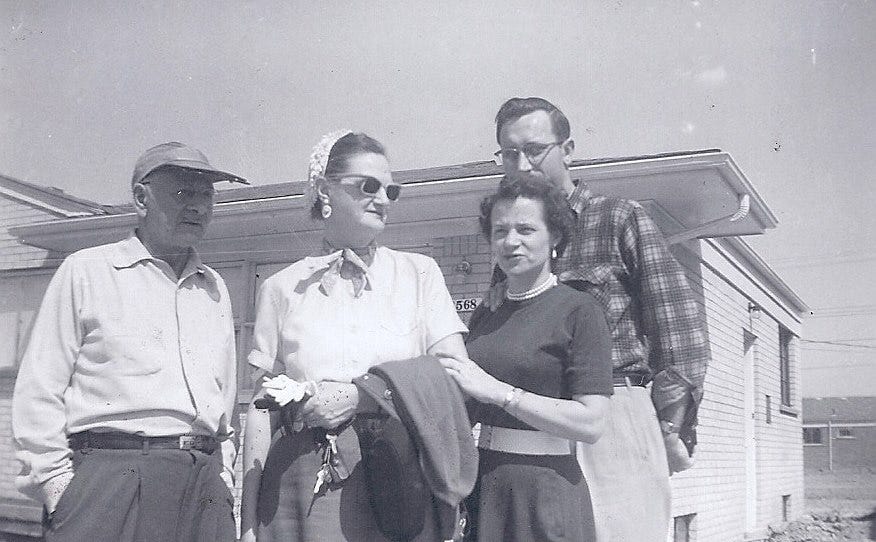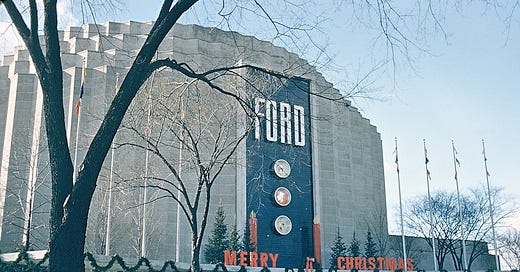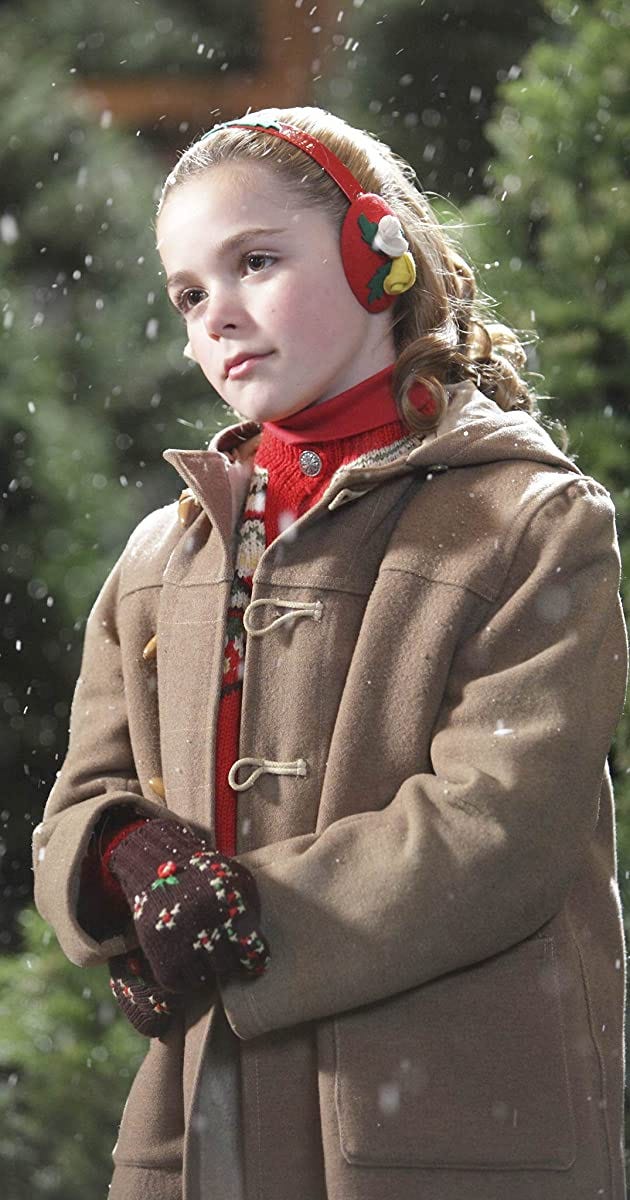
I spent my first two years of life in Dearborn, Henry Ford's hometown. In 1954, the year I was born, the family lived in a small, brick duplex house on Outer Drive, the 40-mile long road once described as a "necklace around Detroit." Outer Drive runs like a "jagged horseshoe from the East Side at Mack Avenue (the Detroit-Grosse Pointe Park border) to Jefferson Avenue in Ecorse Downriver," taking in parts of Dearborn and other western and downriver communities along the way.
By the time of my childhood, Dearborn was the site of Ford headquarters, the Ford estate at Fair Lane, the Rouge Plant, the Ford Rotunda, and Greenfield Village. These were the incongruous spaces of old Henry—a mix of industrial and architectural wonder, antipathy to Detroit (Ford considered himself a farm boy), race segregation (the notorious Orville Hubbard was Dearborn's mayor at the time), and vanity projects that became Disney-like fantasy sites.
My father was employed as a salesman for Stuart Wilson Ford, a Dearborn-based dealership dating from 1947. That job, together with the GI Bill, enabled him to take out a mortgage on a newly built box house in Garden City, a booming suburb fewer than ten miles west of Dearborn.

For me, life began in Garden City and I have been pining for it, some would say moaning about it, ever since:
“… that people could come into the world in a place they could not at first even name and had never known before; and that out of a nameless and unknown place they could grow and move around in it until its name they knew and called with love, and call it home, and put roots there and love others there; so that whenever they left this place they would sing homesick songs about it and write poems of yearning for it, like a lover…” (William Goyen, House of Breath)
But hang on. I came here to talk about Dearborn, the geographical prologue to Garden City. Suppressed, lost, formative. I have little memory of Dearborn, having moved away so young, but two of its places still feature as points on my retrospective maps: Stuart Wilson and the Ford Rotunda.
Stuart Wilson Ford was my father's "field of action," his place out in the world. I can still see him, made mysterious and important by his dark suit, his sober attire set against the candy-colored dream cars of the 50s. He moved among them, carrying a clipboard and pen. I made him important. Not long ago, I met a little girl in a French canal town. Her father sold fries from a broken-down van parked next to the canal. The girl's daughterly pride was fierce, sincere, and unguarded. She told me her father was the most important man in town because everybody came to the van, ordered fries, and talked to him about this and that. Even the mayor did not know what her father knew about the town and its people. I believed her. And I recalled an old sensation of my own, a flutter in the stomach whenever I caught sight of my father in his showroom, selling those bright, gas-guzzling cars.
With its rounded front window, the Stuart Wilson building made modest reference to the Rotunda. The latter was an Albert Kahn design, a massive cylinder-shaped structure to represent Ford Motor Company at the 1934 Chicago World's Fair.
After the Fair, the Rotunda was dismantled and moved to Dearborn where it became the Ford visitor center and, by the 1950s, the nation's fifth most popular tourist destination. The annual Christmas fantasy (with Ford's latest model cars never far from the scene) drew the 50s kids from Dearborn and beyond, attracting six million visitors across nine holiday seasons. Once inside the domed court of the building, we arched our backs to take in the Paul Bunyan-sized Christmas tree, its top branches miles away in the up-spaces. Making our way to Santa's workshop, we passed displays of fairy-tale figurines decked in velvety reds and fake snow.
Today, searching the Rotunda online, I find numerous photographs of the Christmas fantasy and peer at them until my eyes tire of the wretched quest for some record of myself in public history. Might I appear in these Kodachrome scenes of post-war children? The urge to find me is painful because I know that childhood memories turn increasingly elusive as we age. The past changes in shape and content. Momentous passages of youth lose definition or slip from our grasp, while seemingly insignificant ones assume an importance we never suspected at the time. Either way, we lose proof, evidence, and witnesses.
Our places find new uses as they are claimed by succeeding generations. Or they become derelict until they are bulldozed. The materiality of our history recedes or disappears altogether until what occupies us is the nature and practice of memory itself, the feel of memory. Of course, Freud told us long ago that memory is unstable throughout life, not only in old age:
It may indeed be questioned whether we have any memories at all from our childhood: memories relating to our childhood may be all that we possess. Our childhood memories show us our earliest years not as they were but as they appeared at the later periods when the memories were aroused. In these periods of arousal, the childhood memories did not, as people are accustomed to say, emerge; they were formed at that time. And a number of motives, with no concern for historical accuracy, had a part in forming them, as well as in the selection of the memories themselves. (Freud, Screen Memories, 1899)
This instability becomes more difficult with age because we find ourselves more alone. Those who have shared our childhood begin to leave us, one way or another. Those who enter our lives later, well, they inhabit the scenes of future memory. We cannot expect them to care as much about where we came from. Sometimes there seems to be a reprieve when we fall in love. A face across the table in candlelight. Exchanges of heated questions and revelation, more authentic in some than others. "Tell me about your childhood. I want to know everything about you." If we are lucky, we may find this once or twice in life. But even the most ardent lovers gradually stop asking, and we stop asking, too. Love may bind us in other ways, but that particular desire diminishes.
Or consider our children and grandchildren who look forward, as they should. One day, they may feel inclined to look back or know more about who we were, but by then, we may be gone. Each generation experiences its own delayed family historical inquisitiveness. In time, our descendants will glimpse what we begin to know now. The loneliness of memory that has little reference point beyond itself, faint scratchings from behind a wall, a restless mind late at night. But we can't ask children to believe in loss at a time in life when all seems there to be gained, nor should we try.
So if I should find myself, find photographic evidence I was there at the Rotunda, what would it matter? Why persist in these futile searches? The Internet increases the compulsive quality of such longing. I click and google and click some more, and find dozens of little girls at the Rotunda, little Sally Drapers in smart winter coats, paused in front of the displays. I might be any one of them, but upon close inspection, I find I am not.
The retrospective suburban baby boomers embraced Mad Men for all sorts of reasons, but Sally Draper drew particular devotion. Sally stood in for our losses. She made the world young again. She made us young again. We, the girls especially, were Sally Draper. Sally and I were born at the same time. Sally and I lived in 50s suburbia with aspirational fathers and pretty homemaker-mothers. Our family, our house and yard, all these carried the air of perfection and disappointment that hangs so poignantly over the Draper household. I dressed like Sally, took ballet classes, and gave clumsy performances in the living room while my parents sipped Manhattans.
I gazed at my mother in her aprons and pastel nylon nighties. I loved her with a child's ferocity, but with a touch of reluctance, too, catching a whiff of surrender, a narrowing of opportunity that might come eventually to settle on me. Like Sally, I adored my father and longed to be adored in return. He had so much more range and power than my mother. Soon, he would leave Stuart Wilson and become a corporate accountant at Ford Headquarters. He was moving up, though never as high as the men described by Don Draper, Sally's father, as the "Detroit guys." In a later season, the Detroit guys flew to New York to hear pitches and prowl around.
Mad Men was first shown in 2007 when Sally Draper's real-life counterparts had recently passed our 50th birthdays. She tapped straight into our rampant and misguided nostalgia. We could be Sally again, before her (our) future arrived. But we found that she could not take away our knowledge of after. If anything, Sally was written (and beautifully played by Kiernan Shipka) to embody this dilemma for us: a world of before, forever seen through the lens of after.
With each episode, I longed to fade into Sally, and move through childhood as though it were the first time. I longed to erase the changes and events that I knew, full well, would soon disrupt all certainty about the world and unsettle Sally as they had unsettled me: assassinations, urban unrest, Vietnam, Woodstock, the Manson Family, Kent State. And it was not only these public events that troubled us. It was the sporadic glimpses of unhappiness closer to home and in family life. It was the creeping realization that our suburban streets and playgrounds, these lovely spaces for children, were not open to everyone and could not be disentangled from the fortunes of our nearest city, Detroit.
We view our childhoods through these public and private filters. Sally Draper was not there to remove them; she was there to remind us of them. With each season of Mad Men right up to its final episode in 2015, we felt for Sally and watched her growing knowledge and disillusion as though it were our own because it was our own.
The Ford Rotunda was destroyed by fire in November, 1962 and never rebuilt.







Who would have thought that birth into the imperial halls and meadows of a great menacing empire would leave us with uncertain, colored memories, some prim, some grim, and all calling. Your work always calls up my own childhood as a suburban migrant—my family jetted from Massachusetts to California to Pennsylvania and back. Each location with its local color palette and social standards. Very confusing.